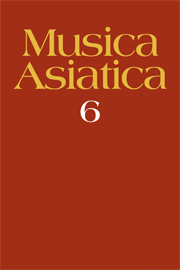Book contents
- Frontmatter
- Contents
- Preface
- Koguryo instruments in Tomb No. 1 at Ch'ang-ch'uan, Manchuria
- Shakuhachi honkyoku notation: written sources in an oral tradition
- The world of a single sound: basic structure of the music of the Japanese flute shakuhachi
- A report on Chinese research into the Dunhuang music manuscripts
- Where did Toragaku come from?
- Musico-religious implications of some Buddhist views of sound and music in the Śūraṅgama Sūtra
- Composition and improvisation in Satsuma biwa
- Glossary of Chinese, Japanese and Korean terms
- Contributors to this volume
- Notes for authors
A report on Chinese research into the Dunhuang music manuscripts
Published online by Cambridge University Press: 05 November 2011
- Frontmatter
- Contents
- Preface
- Koguryo instruments in Tomb No. 1 at Ch'ang-ch'uan, Manchuria
- Shakuhachi honkyoku notation: written sources in an oral tradition
- The world of a single sound: basic structure of the music of the Japanese flute shakuhachi
- A report on Chinese research into the Dunhuang music manuscripts
- Where did Toragaku come from?
- Musico-religious implications of some Buddhist views of sound and music in the Śūraṅgama Sūtra
- Composition and improvisation in Satsuma biwa
- Glossary of Chinese, Japanese and Korean terms
- Contributors to this volume
- Notes for authors
Summary
This paper is a survey of recent Chinese scholarship into the collection of musical notations, believed to be of tenth century date, discovered at Dunhuang. Following a description of the scores and their contents, the author outlines the views that have been put forward by Chinese scholars concerning the nature of the Dunhuang notations, and concludes that they are tablature-notation for pipa (lute). He then examines the tunings that have been adopted in transcribing the notations and discusses Chinese theories concerning the interpretation of rhythm, metre and playing technique. The paper includes four scholars' transcriptions of the piece, Yizhou, from the Dunhuang scores.
Dunhuang, located in the western part of China's Gansu Province, was an ancient holy seat of Buddhism and a strategic place on the Silk Road, the ancient trade route along which eastern and western culture was transmitted. Approximately forty kilometres southeast at Dunhuang is a steep cliff with an average height of seventeen metres where, from the beginning of the fourth century, people dug Buddhist caves (mogao ku). A stone inscription made by Li Huairang in 698 states that at that time there were already more than one thousand caves, and for this reason, the Mogao caves have also come to be known as the ‘Thousand Buddha caves’ (qianfodong).
At the beginning of this century, the caretaker of the Mogao caves, a Daoist monk called Wang, unexpectedly discovered another cave through a crack which had opened up. In this cave, which had long been sealed off, were preserved many Buddhist scriptures and other documents, the latest of which date from 1002.
- Type
- Chapter
- Information
- Musica Asiatica , pp. 61 - 72Publisher: Cambridge University PressPrint publication year: 1991
- 1
- Cited by

